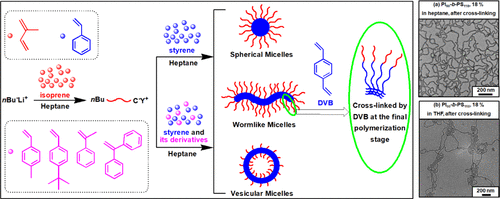当前位置:
X-MOL 学术
›
Macromolecules
›
论文详情
Our official English website, www.x-mol.net, welcomes your
feedback! (Note: you will need to create a separate account there.)
Exploration of a Living Anionic Polymerization Mechanism into Polymerization-Induced Self-Assembly and Site-Specific Stabilization of the Formed Nano-Objects
Macromolecules ( IF 5.1 ) Pub Date : 2020-04-17 , DOI: 10.1021/acs.macromol.0c00371 Jian Wang 1 , Mengya Cao 1 , Peng Zhou 1 , Guowei Wang 1
Macromolecules ( IF 5.1 ) Pub Date : 2020-04-17 , DOI: 10.1021/acs.macromol.0c00371 Jian Wang 1 , Mengya Cao 1 , Peng Zhou 1 , Guowei Wang 1
Affiliation

|
The polymerization-induced self-assembly (PISA) has been developed with great success and rapidly promoted the application of the self-assembly technique in practice. The living anionic polymerization (LAP) is represented as a paragon in polymer chemistry because of its versatility in the synthesis of well-defined model polymers with many advantages. However, the combination of the LAP mechanism with the PISA process is still rarely succeeded and remains a challenge. In this contribution, the LAP PISA was realized by using diblock copolymer polyisoprene-b-polystyrene (PI-b-PS) as a research model. The comprehensive variation of the factors, such as the molecular weights (MWs) of PI and PS segments, targeted MW ratio Mn,PS/Mn,PI, weight solid content, and kinds of comonomers, provided an efficient way to modulate the morphologies. The generated nano-objects included the spherical, wormlike, vesicular micelles, as well as their mixtures. Uniquely, based on the in-situ, site-specific cross-linking of the living species in the final polymerization stage of the LAP PISA process, the generated nano-objects can selectively and efficiently be stabilized by a divinylbenzene agent.
中文翻译:

活性阴离子聚合机制对形成的纳米物体聚合诱导的自组装和特定位点稳定的探索
聚合诱导自组装(PISA)已经取得了巨大的成功,并迅速促进了自组装技术在实践中的应用。活性阴离子聚合反应(LAP)在聚合物化学中表现为典范,因为它在合成具有许多优点的定义明确的模型聚合物中具有多功能性。但是,LAP机制与PISA流程的结合仍然很少成功,仍然是一个挑战。在这项贡献中,LAP PISA是通过使用二嵌段共聚物聚异戊二烯-b-聚苯乙烯(PI- b -PS)作为研究模型来实现的。PI和PS段的分子量(MWs),目标MW比M n,PS / M等因素的综合变化n,PI,重量固体含量和共聚单体的种类提供了一种有效的形态调节方法。产生的纳米物体包括球形的,蠕虫状的,囊泡的胶束及其混合物。独特地,基于LAP PISA过程的最终聚合阶段中生物物种的原位,位点特定的交联,生成的纳米物体可以通过二乙烯基苯试剂选择性地和有效地稳定。
更新日期:2020-04-17
中文翻译:

活性阴离子聚合机制对形成的纳米物体聚合诱导的自组装和特定位点稳定的探索
聚合诱导自组装(PISA)已经取得了巨大的成功,并迅速促进了自组装技术在实践中的应用。活性阴离子聚合反应(LAP)在聚合物化学中表现为典范,因为它在合成具有许多优点的定义明确的模型聚合物中具有多功能性。但是,LAP机制与PISA流程的结合仍然很少成功,仍然是一个挑战。在这项贡献中,LAP PISA是通过使用二嵌段共聚物聚异戊二烯-b-聚苯乙烯(PI- b -PS)作为研究模型来实现的。PI和PS段的分子量(MWs),目标MW比M n,PS / M等因素的综合变化n,PI,重量固体含量和共聚单体的种类提供了一种有效的形态调节方法。产生的纳米物体包括球形的,蠕虫状的,囊泡的胶束及其混合物。独特地,基于LAP PISA过程的最终聚合阶段中生物物种的原位,位点特定的交联,生成的纳米物体可以通过二乙烯基苯试剂选择性地和有效地稳定。


















































 京公网安备 11010802027423号
京公网安备 11010802027423号